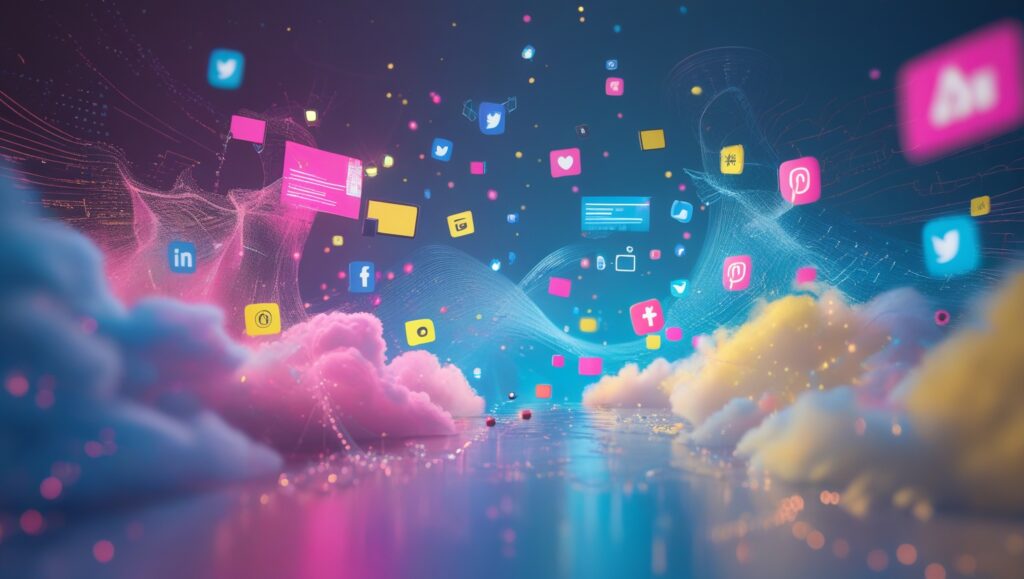AI & Social Media Graphics: A Creative Revolution
Okay, so social media graphics. They’re… important, right? We all know that. But they take time. And sometimes they just don’t *feel* right. You stare at them for hours. Then, suddenly — boom. AI graphic tools start showing up. Now everyone’s talking about it. Is it a thing? Is it just hype? Well, it’s becoming a pretty big thing, and the basics are fairly simple. It lets you create visuals for Instagram, Facebook, Twitter, all of it, but *faster*. And sometimes, surprisingly, better. It’s not necessarily about replacing designers outright, though. It’s more about changing the workflow, and making it possible for anyone to quickly mock up ideas. It’s still developing, of course, so there are trade-offs. But it shifts the whole game.
Understanding the Basics of AI-Powered Graphic Design
First things first, let’s talk about how these tools even work. Most operate on what’s called ‘text to image’ generation. You type in a description – like ‘a cozy coffee shop interior, pastel colors, illustration style’ – and the AI tries to create an image matching that. Honestly, it’s never quite *exactly* what you pictured. That’s the tricky part. But it’s usually a good starting point. The power comes from iteration. You tweak the description, change the style, add details, and regenerate the image until it gets closer to what you want.
A lot of people get stuck trying to be super-specific right away. Don’t. Start broad and refine. Think of it like sculpting. You don’t start with the fingernails. You start with the overall form. There’s a learning curve figuring out what keywords work best for each tool. Some AI systems respond better to certain phrases. Plus, each tool has unique strengths. Midjourney excels at painterly, artistic images. DALL-E 3 is good with realistic photos and understanding precise prompts. Others, like Canva’s AI tools, are built specifically for social media sizing and ease of use. So, picking the right tool is a big first step.
Top AI Tools for Social Media Graphics
Let’s look at some names. Canva’s Magic Studio is really accessible. It’s already integrated with a platform many people use, which is a huge win. You can generate images directly within the Canva interface, then add text, resize for different platforms, and schedule posts. It’s a streamlined experience. But honestly, it’s often less… flexible than some of the more dedicated AI art generators. Another big player is Adobe Firefly. Because it’s Adobe, it plays well with Photoshop and Illustrator, so established designers can weave it into existing workflows. They are also focused on responsible AI – to be fair, this is something a lot of companies are struggling with.
Then there’s Midjourney. It’s accessed through Discord, which feels a bit weird initially, but it’s incredibly powerful for creating stunning visuals. It’s known for its artistic flair, and produces really dreamy, evocative images. But it requires a bit more effort learning the prompt structure. DALL-E 3, created by OpenAI, is another strong contender, and is integrated into ChatGPT Plus. It understands natural language really well, so you can describe what you want in a pretty conversational way. And there are tons of smaller, specialized tools popping up all the time. It can be overwhelming, honestly. Start with one or two and see what fits your style and needs.
Crafting Effective Prompts: The Art of Describing What You Want
Okay, this is where it gets interesting. Prompt engineering – that’s what it’s called. Sounds fancy, but it just means writing good instructions for the AI. A bad prompt will get you a generic, uninspired result. A good prompt… transforms everything. The key isn’t just using keywords, it’s about describing *the mood*, *the style*, *the composition*. Think visually. Don’t just say “cat.” Say “a fluffy orange tabby cat, sunbathing in a field of wildflowers, golden hour lighting, impressionist painting style.” See the difference? It’s a lot to type, but it’s worth it.
People often forget to specify the art style. Do you want a photograph, an illustration, a painting, a cartoon? That makes a huge difference. Also, mentioning artists can influence the output. Something like “in the style of Van Gogh” will give you a very different result than “in the style of Pixar.” It gets tricky with copyright, though – that’s a whole other can of worms. Experiment with adding details about lighting, camera angles, and color palettes. Small tweaks can have a massive impact. And, honestly, don’t be afraid to try completely absurd prompts. You might be surprised by what you get.
Real-World Examples of AI in Social Media Graphics
Let’s get practical. Imagine you’re running a bakery. Instead of hiring a photographer, you could use AI to generate images of beautiful pastries. Or imagine you’re promoting a travel destination. You can create stunning landscapes and cityscapes without ever leaving your desk. Businesses are using it for everything from product mockups to creating engaging social media stories. Take a look at smaller brands – they are really pioneering some cool stuff. Several brands are using AI to create variations of ad copy and imagery to A/B test which performs best, so it helps with data-driven decisions too. They are quickly able to respond to trends and events with targeted visuals.
Another cool use case is creating abstract backgrounds and textures. These can add a unique touch to your social media posts and make them stand out. A lot of accounts are also using AI to create character illustrations for their branding. It’s a way to build a unique visual identity without the cost of traditional illustration. It’s important to remember that the best results come from combining AI with your own creativity. Use AI as a tool to enhance your vision, not replace it. A lot of brands get caught up in the ‘wow’ factor and just dump AI images on their feed with no clear strategy. That doesn’t usually work.
Addressing the Challenges and Limitations
It’s not all rainbows and unicorns. One of the biggest challenges is consistency. Getting the same character to look the same across multiple images can be tough. The AI often introduces slight variations, which can be jarring. Another limitation is detail. AI-generated images sometimes struggle with complex details, like hands or faces. They can look… off. It’s getting better, but it’s still a common issue. There’s also the ethical concern about copyright and AI-generated art. Who owns the artwork? And is it ethical to use AI to create art that mimics the style of human artists?
To be fair, these are questions the legal system is still trying to answer. And then there’s the potential for misuse. AI can be used to create deepfakes and spread misinformation. It’s important to be aware of these risks and use AI responsibly. Also, don’t expect perfect results every time. AI is still a tool, and it requires skill and effort to get the most out of it. It’s also important to understand the limitations of each tool and choose the right one for the job. A lot of people underestimate the time it takes to refine the AI-generated images. It’s rarely a one-and-done process.
Tips for Beginners: Getting Started with AI Graphics
Start small. Pick one tool and focus on learning its strengths and weaknesses. Don’t try to master everything at once. Experiment with different prompts and see what works. Don’t be afraid to iterate – the more you refine your prompts, the better the results will be. Spend time browsing the communities around these tools (Reddit, Discord). You’ll find tons of inspiration and helpful tips.Remember, the first versions are going to be bad. That’s normal. Embrace the learning process.
Learn to use negative prompts. These tell the AI what *not* to include in the image. For example, “no blurry textures, no distorted faces.” This is a powerful technique for improving the quality of your images. Also, don’t be afraid to combine AI-generated images with traditional design elements. Add text, graphics, or photos to create a unique and compelling visual. It’s worth exploring the inpainting and outpainting features of some tools, allowing precise editing of generated images. Finally, remember that AI is a tool to *help* you create, not to replace your creativity.
The Future of AI in Social Media Graphics
Honestly, it’s going to change everything. We’ll see AI becoming even more integrated into the social media platforms themselves. Imagine being able to generate graphics directly within Facebook or Instagram. We’ll also see more sophisticated AI tools that can understand even more complex prompts. And the quality of the images will continue to improve. AI will also likely play a larger role in personalizing social media content. It could be used to create graphics that are tailored to each individual user’s preferences.
There’s also a growing trend towards ‘AI-assisted design’. Tools that help you refine your designs using AI-powered suggestions. It’s not just about generating images from scratch, it’s about augmenting your existing design skills with AI. The lines will blur between human and artificial creativity. And, to be fair, this is scary for some people. But it’s also incredibly exciting. It opens up new possibilities for visual storytelling. The only way to be ready is to embrace these tools and learn how to use them effectively.
Quick Takeaways
- Start simple with your prompts. Refine gradually.
- Don’t be afraid to experiment. Try absurd requests.
- AI isn’t a replacement for creativity. It’s an enhancement.
- Copyright is a blurry area. Be cautious and informed.
- Iteration is key. Expect multiple re-generations.
- Specific art styles matter. Describe what *kind* of image you want.
- Small details count. Lighting, angles, and colors are powerful.
Conclusion
So, yeah. AI in social media graphics is a big deal. It’s not a magic bullet, but it’s a powerful tool that can save you time, money, and effort. It’s changing the landscape for designers, marketers, and anyone who wants to create visually appealing content. The speed of innovation is startling, so continuous learning will be key to stay on top of it. The biggest takeaway? Don’t be afraid to try it. Dive in, experiment, and see what you can create. We’ve all learned the hard way that waiting for ‘perfection’ means missing the boat.
FAQs
What is the best AI tool for someone with no design experience?
Canva’s Magic Studio is probably the most user-friendly option for beginners. It’s integrated with a platform you might already be using, and its interface is relatively simple to navigate. You can get started quickly without a steep learning curve.
Are there any copyright concerns with AI-generated images?
Yes, absolutely. The copyright landscape is still evolving. Generally, you own the copyright to the images you generate, but there are questions about whether training data used by the AI models infringes on the rights of artists whose work was included in that data. It’s a complex legal issue.
How long does it typically take to create a good AI-generated graphic?
It varies, but don’t expect instant results. It can take anywhere from a few minutes to several hours to get an image that you’re happy with. A lot of time is spent refining the prompt and regenerating the image multiple times. So factor in some experimentation and editing time.
Can AI graphics be used for commercial purposes?
Generally, yes, but read the terms of service for the specific AI tool you’re using. Some tools have restrictions on commercial use. Also, be mindful of the copyright concerns mentioned earlier. Verify you’re covered legally before using an AI-generated image for a business purpose.
What are negative prompts and why are they useful?
Negative prompts tell the AI what *not* to include in the image. For example, if you don’t want blurry details, you would add “blurry” to the negative prompt. They’re incredibly useful for refining the output and avoiding unwanted elements, directing the AI towards better results.


